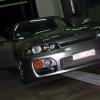Boost Response Help!
Announcements
-
Similar Content
-
Latest Posts
-
To expand on this to help understanding... The bigger/longer the block is, the more it's going to work to sit on your far away high areas, and not touch the low stuff in the middle. When you throw the guide coat, and give it a quick go with a big block, guide coat will disappear in the high spots. If those high spots are in the correct position where the panel should be, stop sanding, and fill the low spots. However, using a small block, you "fall off" one of the high spots, and now your sanding the "side of the hill". Your little block would have been great for the stone chips, where you only use a very small amount of filler, so you're sanding and area let's say the size of a 5/10cent piece, with something that is 75*150. For the big panel, go bigger! And now I'll go back to my "body work sucks, it takes too much patience, and I don't have it" PS, I thought your picture with coloured circles was an ultra sound... That's after my brain thought you were trying to make a dick and balls drawing...
-
By Murray_Calavera · Posted
Oh I probably didn't speak enough about the small sanding block for blocking large areas. In the video about 3 minutes in, he talks about creating valleys in the panel. This is the issue with using a small sanding block for a large area, it's way too easy to create the valleys he is talking about. With a large block its much easier to create a nice flat surface. Hard to explain but in practice you'll notice the difference straight away using the large block. -
By Murray_Calavera · Posted
Yep I guessed as much. You'll find life much easier with a large block something like this - https://wholesalepaint.com.au/products/dura-block-long-hook-loop-sanding-block-100-eva-rubber-af4437 This is a good demo video of something like this in use - You have turned your small rock chip holes into large low spots. You'll need to fill and block these low spots. It's always a little hard not seeing it in person, but yes I would go ahead and lay filler over the whole area. Have a good look at the video I linked, it's a very good example of all the things you're doing. They went to bare metal, they are using guide coat, they are doing a skim coat with the filler and blocking it back. If what you're doing doesn't look like what they are doing, that's a big hint for you -
The odometer does go up when driving. Does this tell it is an issue with the speedometer itself? Where can I look for replacement cluster? Or speedo? I can likely do the repair.. Will ER34 cluster work on HR34? Or do I need a HR34 20GT S2 specifically lol
-
Mine's a bit bigger at 70x150mm roughly. The spots are flat, just can feel the edges if I dig my nail into it. I did fix some other other ones by both using my finger to sand that small spot (I'm a bit wary of doing this and creating hot spots and a bigger mess) and I also did sand over it flat and others, but this also worried me a bit because if I create an overall low spot on the panel on paint that is good. Correct me if I'm wrong but as long as it's flat even if I can feel the edges, I can put filler because it will all be level once I sand it? I can see myself going in a circle after sanding guidecoat with 320 grit if for example the panel is flat with my hand but because I sanded the guidecoat I could have created a low spot again somewhere. Unless where I'm going wrong is what I mentioned previously where I didn't go low enough on the grits. It's 1 step forward and 2 step backwards here haha. I'll probably need to experiment with it more. Last time I go back to bare metal lol.
-






Recommended Posts
Create an account or sign in to comment
You need to be a member in order to leave a comment
Create an account
Sign up for a new account in our community. It's easy!
Register a new accountSign in
Already have an account? Sign in here.
Sign In Now